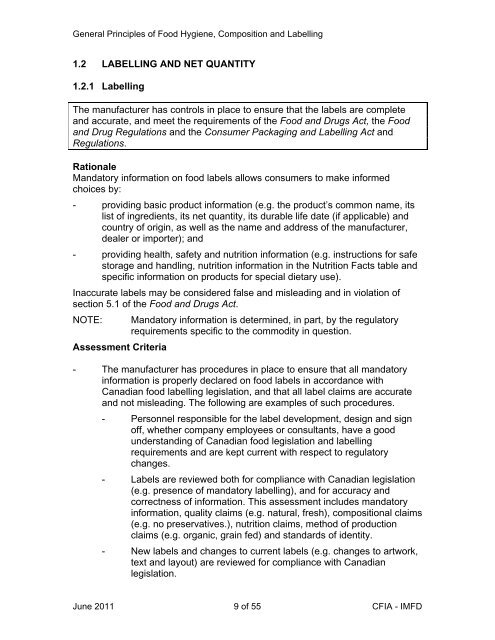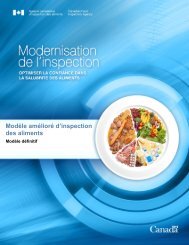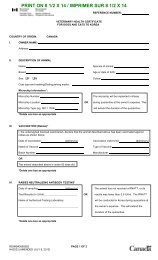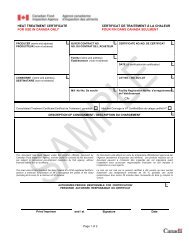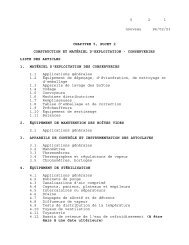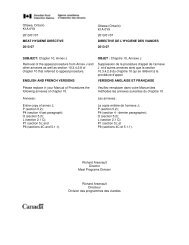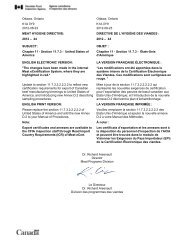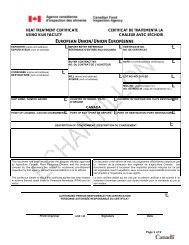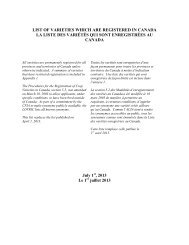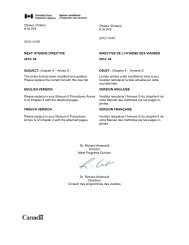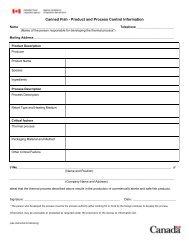General Principles of Food Hygiene, Composition and Labelling
General Principles of Food Hygiene, Composition and Labelling
General Principles of Food Hygiene, Composition and Labelling
You also want an ePaper? Increase the reach of your titles
YUMPU automatically turns print PDFs into web optimized ePapers that Google loves.
<strong>General</strong> <strong>Principles</strong> <strong>of</strong> <strong>Food</strong> <strong>Hygiene</strong>, <strong>Composition</strong> <strong>and</strong> <strong>Labelling</strong>1.2 LABELLING AND NET QUANTITY1.2.1 <strong>Labelling</strong>The manufacturer has controls in place to ensure that the labels are complete<strong>and</strong> accurate, <strong>and</strong> meet the requirements <strong>of</strong> the <strong>Food</strong> <strong>and</strong> Drugs Act, the <strong>Food</strong><strong>and</strong> Drug Regulations <strong>and</strong> the Consumer Packaging <strong>and</strong> <strong>Labelling</strong> Act <strong>and</strong>Regulations.RationaleM<strong>and</strong>atory information on food labels allows consumers to make informedchoices by:- providing basic product information (e.g. the product’s common name, itslist <strong>of</strong> ingredients, its net quantity, its durable life date (if applicable) <strong>and</strong>country <strong>of</strong> origin, as well as the name <strong>and</strong> address <strong>of</strong> the manufacturer,dealer or importer); <strong>and</strong>- providing health, safety <strong>and</strong> nutrition information (e.g. instructions for safestorage <strong>and</strong> h<strong>and</strong>ling, nutrition information in the Nutrition Facts table <strong>and</strong>specific information on products for special dietary use).Inaccurate labels may be considered false <strong>and</strong> misleading <strong>and</strong> in violation <strong>of</strong>section 5.1 <strong>of</strong> the <strong>Food</strong> <strong>and</strong> Drugs Act.NOTE: M<strong>and</strong>atory information is determined, in part, by the regulatoryrequirements specific to the commodity in question.Assessment Criteria- The manufacturer has procedures in place to ensure that all m<strong>and</strong>atoryinformation is properly declared on food labels in accordance withCanadian food labelling legislation, <strong>and</strong> that all label claims are accurate<strong>and</strong> not misleading. The following are examples <strong>of</strong> such procedures.- Personnel responsible for the label development, design <strong>and</strong> sign<strong>of</strong>f, whether company employees or consultants, have a goodunderst<strong>and</strong>ing <strong>of</strong> Canadian food legislation <strong>and</strong> labellingrequirements <strong>and</strong> are kept current with respect to regulatorychanges.- Labels are reviewed both for compliance with Canadian legislation(e.g. presence <strong>of</strong> m<strong>and</strong>atory labelling), <strong>and</strong> for accuracy <strong>and</strong>correctness <strong>of</strong> information. This assessment includes m<strong>and</strong>atoryinformation, quality claims (e.g. natural, fresh), compositional claims(e.g. no preservatives.), nutrition claims, method <strong>of</strong> productionclaims (e.g. organic, grain fed) <strong>and</strong> st<strong>and</strong>ards <strong>of</strong> identity.- New labels <strong>and</strong> changes to current labels (e.g. changes to artwork,text <strong>and</strong> layout) are reviewed for compliance with Canadianlegislation.June 2011 9 <strong>of</strong> 55 CFIA - IMFD


